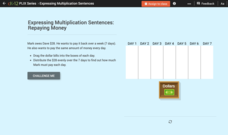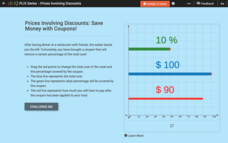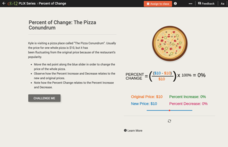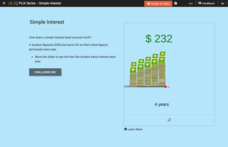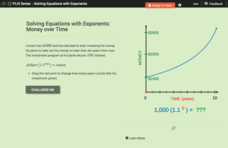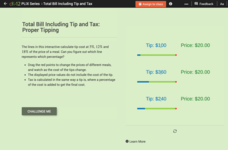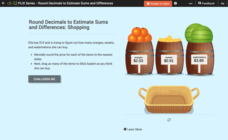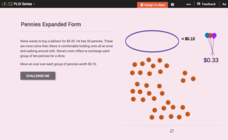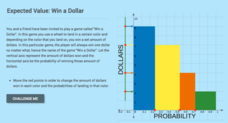CK-12 Foundation
Whole Number Division: Repaying Money
Mathematicians answer five word problems in an interactive practice all about repaying money using division. A calendar and moveable dollar bills aides participants in finding solutions to multiple-choice, fill-in-the-blank, and...
CK-12 Foundation
Domain and Range of a Function: Making Money Math
Graphs are useful for many things, including seeing how much money you can make. Individuals create a graph of earnings from a job based on the number of hours. They determine the domain and range of the graph and answer challenge...
CK-12 Foundation
Prices Involving Discounts: Save Money with Coupons!
Nine questions make up an interactive that challenges scholars to identify new prices after discounts. Question types include fill in the blank and multiple choice. A fully-functional tool assists participants in solving word problems....
Scholastic
Study Jams! Making Change
This dreamy resource has little ones computing the change on the purchase of an ice cream cone. Mia describes each step in two methods: subtraction of decimals and counting up from the sale price.
Scholastic
Study Jams! Fractions
What can quesadillas teach your class about fractions? More than you might think. AJ and Zoe from the StudyJams! crew use this Mexican cuisine to explain how fractions are just equal parts of a whole, defining the key terms numerator and...
CK-12 Foundation
Division of Decimals by Whole Numbers: Lemonade Stand
After a full day of selling lemonade, three friends split the cost of the profit money. If the total profit was $34.20, how much will each friend get?
CK-12 Foundation
Percent of Change: The Pizza Conundrum
Nine questions—multiple choice and fill in the blank—challenge mathematicians to solve money word problems. Looking closely at prices, scholars use a formula to identify percent increases and decreases based on an original and new price....
CK-12 Foundation
Simple Interest
Mathematicians manipulate a mountain of money to solve six questions about simple interest. Question types include several multiple-choice and one discussion.
CK-12 Foundation
Counting Events: Flipping Unfair Coins
Who said life was fair? An interactive uses an area diagram to represent the probabilities of flipping unfair coins. Pupils use the diagram to calculate the probabilities of outcomes of flipping the two coins. The scholars must decide...
CK-12 Foundation
Solving Equations with Exponents: Money Over Time
We'd all like to see our money double. An interactive shows how an initial investment of $1,000 will increase using a constant rate of return. Scholars answer a set of challenge questions based on the situation.
CK-12 Foundation
Mode: Mucho Money
Generate stacks of money. Given bills of different denominations, pupils stack them based on their values. The learners figure out which value is the mode of the data and determine whether the data is unimodal, bimodal, or multimodal.
CK-12 Foundation
Prices Involving Sales Tax: Proper Tipping
A five-question interactive challenges mathematicians to find a correct tip and total amount using percents five, 12, and 18. A tool with moveable pieces assists participants in locating answers. Types of questions include...
CK-12 Foundation
Problem Solving Plan, Estimation with Decimals: Shopping
Mathematicians go on a virtual shopping trip in an interactive designed to boost the concept of estimation. Scholars read and answer five questions—multiple-choice, true or false, and a discussion—with help from a drag-and-drop shopping...
CK-12 Foundation
Function Rules based on Graphs: Making Money in the Hat Business
Hats off to those learning about the graphs of functions. Individuals use an interactive to plot points representing profits for a hat business. They identify a quadratic equation to represent this function and answer challenge questions...
Curated OER
TAKS Math Quiz-Currency Problems
In this TAKS math quiz worksheet, students take an online quiz focused on problems using currency. Quiz may be graded online by clicking a link.
CK-12 Foundation
Displaying Categorical Variables: Spending Habits
Bar or circle graph—which is best? Given a circle graph and a total amount of money earned, pupils calculate the amount of money in each category. Learners use the calculated amounts to create a bar graph and compare the two displays.
CK-12 Foundation
Numbers in Expanded Form: Pennies Expanded Form
Beginning with a word problem that poses the question of making groups of 10 pennies to translate into a single dime, pupils are challenged to make sense of the amount of dollars 33 cents is in expanded form.
CK-12 Foundation
Expected Value: Game of Chance
Determine whether the payoff is worth it. Pupils calculate the expected value of a game with three different payoff levels. Each level has a different probability of winning money. The scholars find the expected payoffs for each...
CK-12 Foundation
Expected Value: Win a Dollar
Spin a wheel, land on a color ... and win. Learners create a graph to display the probabilities of the amount of money they can win by spinning a colored wheel. The pupils use the dollar amounts and their probabilities to calculate the...
CK-12 Foundation
Numerical Computations: Counting Out Probability
Keep your heads up while counting. Pupils use an interactive to create a table with the possible outcomes of flipping three coins and then determine the probabilities of getting certain combinations of heads and tails.
CK-12 Foundation
Multi-Step Equations with Like Terms: Shipments
Who doesn't like boxes of money? A drag-and-drop interactive lets users separate variables and constants to combine like terms. They answer a set of challenge questions based on the results of the interactive.
CK-12 Foundation
Checking Solutions to Inequalities: Apples and Bananas Shopping Excursion
Go bananas over a fun interactive! Learners drag a point on a virtual graph of an inequality to see if it is a solution. This helps determine the possible numbers of apples and bananas a shopper can buy with a given amount of money.
CK-12 Foundation
Even and Odd Functions and Function Symmetry: Even and Odd Functions (Symmetry)
Even money states that the resource is good to use. Scholars manipulate an interactive to adjust the portion of a graph to the left of the y-axis. The interactive allows them to switch between even and odd modes that show the right side...
CK-12 Foundation
Discrete Random Variables: Roll the Dice!
And the winner is ... not always who it appears to be. An interactive gives the directions for a dice game that on the surface gives one player an advantage over the other. Pupils look closer at the possible outcomes and find the...
